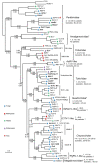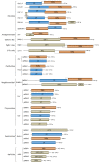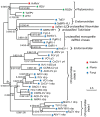Evolutionary genomics of mycovirus-related dsRNA viruses reveals cross-family horizontal gene transfer and evolution of diverse viral lineages
- PMID: 22716092
- PMCID: PMC3483285
- DOI: 10.1186/1471-2148-12-91
Evolutionary genomics of mycovirus-related dsRNA viruses reveals cross-family horizontal gene transfer and evolution of diverse viral lineages
Abstract
Background: Double-stranded (ds) RNA fungal viruses are typically isometric single-shelled particles that are classified into three families, Totiviridae, Partitiviridae and Chrysoviridae, the members of which possess monopartite, bipartite and quadripartite genomes, respectively. Recent findings revealed that mycovirus-related dsRNA viruses are more diverse than previously recognized. Although an increasing number of viral complete genomic sequences have become available, the evolution of these diverse dsRNA viruses remains to be clarified. This is particularly so since there is little evidence for horizontal gene transfer (HGT) among dsRNA viruses.
Results: In this study, we report the molecular properties of two novel dsRNA mycoviruses that were isolated from a field strain of Sclerotinia sclerotiorum, Sunf-M: one is a large monopartite virus representing a distinct evolutionary lineage of dsRNA viruses; the other is a new member of the family Partitiviridae. Comprehensive phylogenetic analysis and genome comparison revealed that there are at least ten monopartite, three bipartite, one tripartite and three quadripartite lineages in the known dsRNA mycoviruses and that the multipartite lineages have possibly evolved from different monopartite dsRNA viruses. Moreover, we found that homologs of the S7 Domain, characteristic of members of the genus phytoreovirus in family Reoviridae are widely distributed in diverse dsRNA viral lineages, including chrysoviruses, endornaviruses and some unclassified dsRNA mycoviruses. We further provided evidence that multiple HGT events may have occurred among these dsRNA viruses from different families.
Conclusions: Our study provides an insight into the phylogeny and evolution of mycovirus-related dsRNA viruses and reveals that the occurrence of HGT between different virus species and the development of multipartite genomes during evolution are important macroevolutionary mechanisms in dsRNA viruses.
Figures








Similar articles
-
Characterization of a Novel Megabirnavirus from Sclerotinia sclerotiorum Reveals Horizontal Gene Transfer from Single-Stranded RNA Virus to Double-Stranded RNA Virus.J Virol. 2015 Aug;89(16):8567-79. doi: 10.1128/JVI.00243-15. Epub 2015 Jun 10. J Virol. 2015. PMID: 26063429 Free PMC article.
-
Discovery of novel dsRNA viral sequences by in silico cloning and implications for viral diversity, host range and evolution.PLoS One. 2012;7(7):e42147. doi: 10.1371/journal.pone.0042147. Epub 2012 Jul 27. PLoS One. 2012. PMID: 22848734 Free PMC article.
-
Co-infection of a hypovirulent isolate of Sclerotinia sclerotiorum with a new botybirnavirus and a strain of a mitovirus.Virol J. 2016 Jun 6;13:92. doi: 10.1186/s12985-016-0550-2. Virol J. 2016. PMID: 27267756 Free PMC article.
-
[Diverse double-stranded RNA viruses infecting fungi].Uirusu. 2014;64(2):225-38. doi: 10.2222/jsv.64.225. Uirusu. 2014. PMID: 26437844 Review. Japanese.
-
A neo-virus lifestyle exhibited by a (+)ssRNA virus hosted in an unrelated dsRNA virus: Taxonomic and evolutionary considerations.Virus Res. 2018 Jan 15;244:75-83. doi: 10.1016/j.virusres.2017.11.006. Epub 2017 Nov 6. Virus Res. 2018. PMID: 29122644 Review.
Cited by
-
A virus from Aspergillus cibarius with features of alpha- and betachrysoviruses.Virus Genes. 2024 Feb;60(1):71-79. doi: 10.1007/s11262-023-02043-6. Epub 2023 Dec 30. Virus Genes. 2024. PMID: 38160229 Free PMC article.
-
Molecular Characterization of a Chrysovirus Isolated From the Citrus Pathogen Penicillium crustosum and Related Fungicide Resistance Analysis.Front Cell Infect Microbiol. 2019 May 15;9:156. doi: 10.3389/fcimb.2019.00156. eCollection 2019. Front Cell Infect Microbiol. 2019. PMID: 31157173 Free PMC article.
-
Viral discovery and diversity in trypanosomatid protozoa with a focus on relatives of the human parasite Leishmania.Proc Natl Acad Sci U S A. 2018 Jan 16;115(3):E506-E515. doi: 10.1073/pnas.1717806115. Epub 2017 Dec 28. Proc Natl Acad Sci U S A. 2018. PMID: 29284754 Free PMC article.
-
Molecular Characterization of a Novel Positive-Sense, Single-Stranded RNA Mycovirus Infecting the Plant Pathogenic Fungus Sclerotinia sclerotiorum.Viruses. 2015 May 21;7(5):2470-84. doi: 10.3390/v7052470. Viruses. 2015. PMID: 26008696 Free PMC article.
-
Small RNA-Based Antiviral Defense in the Phytopathogenic Fungus Colletotrichum higginsianum.PLoS Pathog. 2016 Jun 2;12(6):e1005640. doi: 10.1371/journal.ppat.1005640. eCollection 2016 Jun. PLoS Pathog. 2016. PMID: 27253323 Free PMC article.
References
-
- King AMQ, Adams MJ, Carstens EB, Lefkowitz EJ. (Eds): Virus taxonomy: Ninth Report of the International Committee on taxonomy of viruses. New York: Elsevier; 2011.
Publication types
MeSH terms
Substances
LinkOut - more resources
Full Text Sources

